21. Logical Venn diagrams
Sakshi Education

EXERCISE:
- How many triangles are there in the adjacent figure?
(1) 18
(2) 20
(3) 22
(4) 24
(5) None of these
- How many quadrilaterals are there in the adjacent figure A?
(1) 8
(2) 9
(3) 10
(4) 12
(5) None of these
- How many squares are there in the adjacent figure?

(1) 53
(2) 54
(3) 55
(4) 56
(5) None of these
- How many rectangles are there in the adjacent figure?

(1) 156
(2) 162
(3) 168
(4) 175
(5) None of these
- How many squares are there in the adjacent figure?

(1) 60
(2) 54
(3) 58
(4) 62
(5) None of these
- How many rectangles are there in the adjacent figure?
 (
(
1) 232
(2) 226
(3) 222
(4) 220
(5) None of these
- How many triangles are there in the adjacent figure?

(1) 10
(2) 12
(3) 14
(4) 16
(5) None of these
- How many quadrilaterals are there in the adjacent figure?
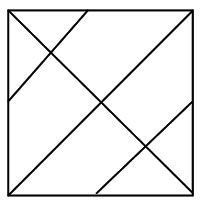
(1) 6
(2) 9
(3) 11
(4) 13
(5) None of these
- How many squares are there in the adjacent figure?

(1) 21
(2) 23
(3) 25
(4) 27
(5) None of these
- How many rectangles are there in the adjacent figure?

(1) 52
(2) 50
(3) 54
(4) 56
(5) None of these
- How many cubes are there in the adjacent figure?
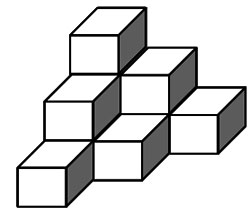
(1) 6
(2) 9
(3) 10
(4) 12
(5) None of these
- How many triangles are there in the adjacent figure?
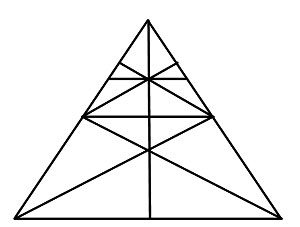
(1) 44
(2) 46
(3) 49
(4) 51
(5) None of these
Directions (13 –15):- Study the following figure carefully and answer the questions given below.
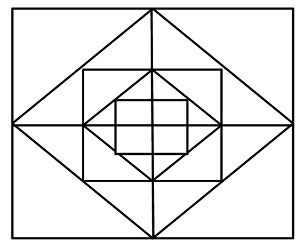
- How many squares are there in the above figure?
(1) 12
(2) 13
(3) 16
(4) 17
(5) None of these
- How many rectangles are there in the above figure?
(1) 16
(2) 8
(3) 12
(4) 20
(5) None of these
- How many Triangles are there in the above figure?
(1) 48
(2) 44
(3) 56
(4) 64
(5) None of these
- How many cubes are there in the adjacent figure?

(1) 10
(2) 16
(3) 20
(4) 24
(5) None of these
Directions (17-19): Study the following diagram carefully and answer the questions given below:

- How many squares are there in the above figure?
(1) 14
(2) 13
(3) 16
(4) 10
(5) None of these
- How many rectangles are there in the above figure?
(1) 8
(2) 11
(3) 14
(4) 17
(5) None of these
- How many Triangles are there in the above figure?
(1) 69
(2) 70
(3) 71
(4) 72
(5) None of these
Directions (20-22): Observe the following figure and then answer the questions given:
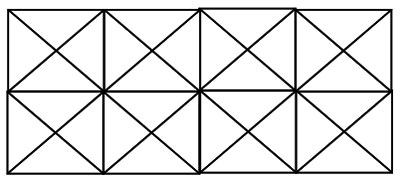
- How many Triangles are there in the above figure?
(1) 120
(2) 90
(3) 72
(4) 64
(5) None of these
- How many squares are there in the above figure?
(1) 16
(2) 11
(3) 24
(4) 21
(5) None of these
- How many rectangles are there in the above figure?
(1) 33
(2) 36
(3) 24
(4) 32
(5) None of these
- The triangles, square and circle shown below respectively represent urban, hardworking and educated people. Which one of the areas marked I-VII represents the urban educated who are not hard working?
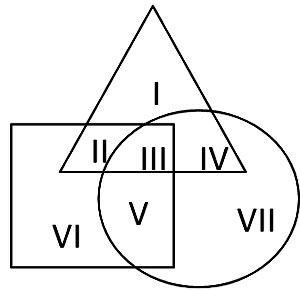
(1) II
(2) I
(3) IV
(4) III
(5) None of these
Directions (24- 26): The diagram shown below represents 3 segments of society overlapping each other viz.

Circle – Educated youth
Triangle – Unemployed youth
Square – Employed youth
Based on the above relationships given in the diagram you have to point out which number represents the following statements.
- Some educated youths are employed
(1) (2) (3) (4) (5) (6)
- Some youths are neither educated nor employed
(1) (2) (3) (4) (5) (6)
- Some educated youths are not employed
(1) (2) (3) (4) (5) (6)
Directions (27 – 32): The diagram shown below represents four types of literates which knows English, Hindi, Punjabi and Urdu. Based on above information try to solve questions which follow:
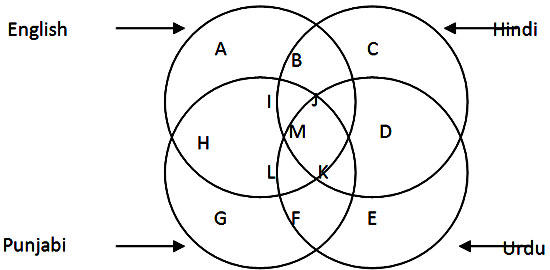
- People who can read and write Hindi, Urdu and Punjabi are represented by
(1) A
(2) D
(3) K
(4) E
(5) F
- People who can read write all the languages are represented by
(1) L
(2) J
(3) M
(4) I
(5) D
- People who can read and write all languages except Urdu are represented by
(1) K
(2) M
(3) C
(4) E
(5) F
- People who cannot read and write English, Hindi and Punjabi are represented by
(1) L
(2) K
(3)C
(4) E
(5) F
- People who cannot read and write Urdu and Punjabi, but are conversant with English and Hindi both are represented by?
(1) M
(2) B
(3) J
(4) K
(5) I
- People who do not know English and Hindi but are familiar with Urdu and Punjabi both are represented by
(1) F
(2) G
(3) E
(4) K
(5) M
Directions (33-37): Study the figure carefully and answer the question.
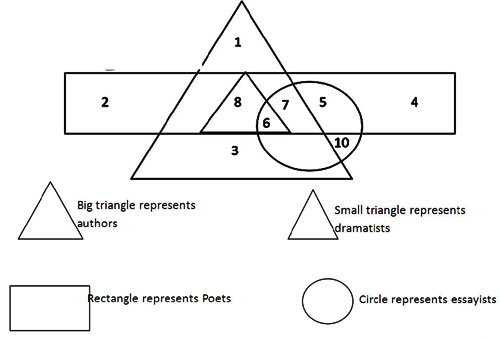
- Which number represents poets who were also essayists, dramatists and authors?
(1) 7
(2) 5
(3) 6
(4) 8
- Which number represents dramatists who are not essayists?
(1) 8
(2) 7
(3) 5
(4) 1
- Which number represents poets who are also essayists but not authors or dramatists?
(1) 5
(2) 6
(3) 7
(4) 8
- Which numbers represents only Authors who are neither poet nor dramatists or essayists?
(1) 2 and 3
(2) 1 and 3
(3) 4 and 5
(4) 8 and 6
- Which numbers represents poet who are neither author nor essayists or dramatists?
(1) 2 and 4
(2) 8 and 3
(3) 7 and 9
(4) 5 and 1
Directions (38-42): Study the figure carefully and answer the questions that follow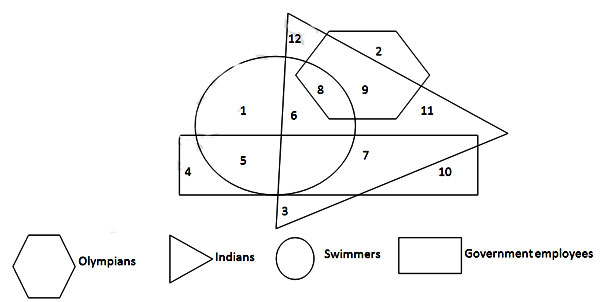
- Which number represents Indians who are neither swimmers nor govt. employees and never been to Olympics?
(1) 3, 11 and 12
(2) 3 and 12 only
(3) 3, 7 and 10
(4) 3, 4 and 10
- Non- Indian swimmers who are Olympians also are represented by
(1) 1
(2) 2
(3) 5
(4) 6
(5) None
- Non Indian Olympians are represented by number
(1) 1
(2) 2
(3) 3
(4) 4
(5) 5
- Chances of having a govt. employee being an Olympian are (based on the diagram)
(1) Occasional
(2) Always
(3) Never
(4) Very little
(5) Date Inadequate
- Number 6 represents
(1) Indian swimmers
(2) Indian govt. employees who are swimmers also
(3) Non – Olympians, non Indian Swimmers
(4) Non Indian govt. employees
(5) None of these
Directions (43-47): The following questions are based on the diagrams given below in which the triangle represents females, small hexagon represents college students and big hexagon represents singers.

- Students studying in D.A.V college for boys and who could sing well are represented by
(1) 6
(2) 1
(3) 9
(4) 3
(5) 2
- Females who are neither singers nor students are represented by
(1) 3
(2) 4
(3) 2
(4) 6
(5) 9
- Students who are neither singers nor female are represented by
(1) 3
(2) 8
(3) 9
(4) 2
(5) 3 and 9
- Male singers who are not college students are represented by
(1) 1
(2) 2
(3) 3
(4) 1 and 2
(4) 1 and 4
- College students are female singers as well can be denoted by
(1) 5
(2) 6
(3) 8
(4)9
(5) 4
- Which combination figure of the rectangles best represents the relationship between the mosquitoes, ants and insects?

- Which of the following diagrams best depicts cousins, nephews and males?

- Which of the following combination of circles best represents athletes, sprinters and marathon runners?

- Which of the following combination of triangles best represents cubs, mules and monkeys?
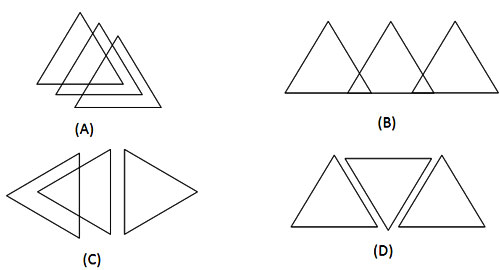
- Which of the following combination of figures best represents males, dogs and pets?
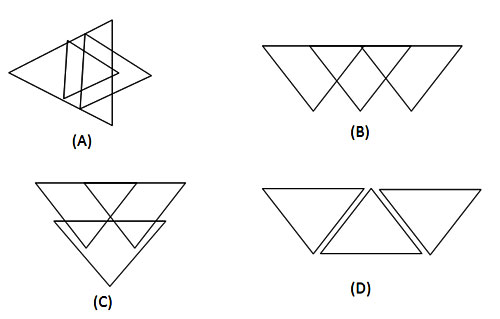
- Which combination of rectangles best represents the relationship between tehsil, district and state?
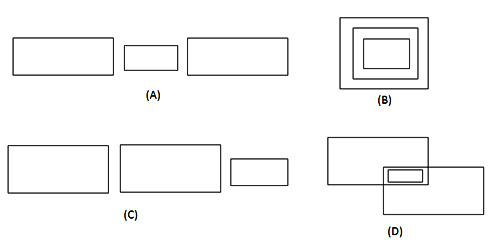
- If vehicles running on diesel and petrol are represented by two large rectangles, which diagram will show correct position of jeeps driven by both on petrol and diesel?

- The diagram below depicts BSc (Hons) students, studying Chemistry, Physics and Mathematics. What does the shaded portion depict?

A. Students studying Chemistry
B. Students studying Physics
C. Students studying Mathematics
(1) Students who study chemistry and Physics
(2) Students who study Physics and Mathematics
(3) Students who study Chemistry, Physics and Mathematics
(4) Students studying Chemistry and Mathematics
| ANSWER KEY | |||||||||||
| 1 | 2 | 11 | 3 | 21 | 3 | 31 | 2 | 41 | 3 | 51 | 4 |
| 2 | 3 | 12 | 4 | 22 | 5 | 32 | 1 | 42 | 1 | 52 | 1 |
| 3 | 3 | 13 | 4 | 23 | 3 | 33 | 3 | 43 | 1 | 53 | 2 |
| 4 | 5 | 14 | 3 | 24 | 2 | 34 | 1 | 44 | 2 | 54 | 4 |
| 5 | 1 | 15 | 1 | 25 | 5 | 35 | 1 | 45 | 5 | 55 | 3 |
| 6 | 4 | 16 | 3 | 26 | 1 | 36 | 2 | 46 | 4 | ||
| 7 | 3 | 17 | 1 | 27 | 3 | 37 | 1 | 47 | 1 | ||
| 8 | 3 | 18 | 4 | 28 | 3 | 38 | 1 | 48 | 3 | ||
| 9 | 2 | 19 | 1 | 29 | 4 | 39 | 5 | 49 | 3 | ||
| 10 | 5 | 20 | 5 | 30 | 4 | 40 | 2 | 50 | 1 | ||
Prepared by,
IACE, Hyderabad.
Published date : 08 Jun 2015 12:07PM













